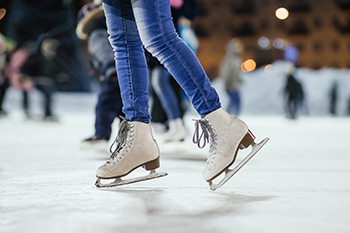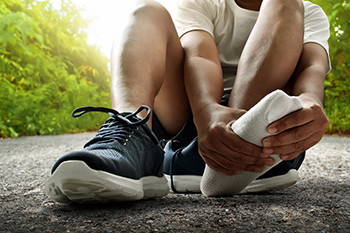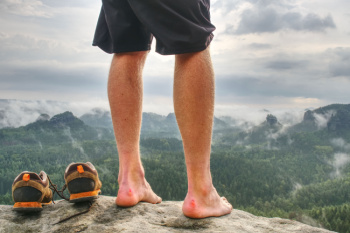Items filtered by date: February 2025
Common Causes of Ankle Pain While Cycling

Ankle pain during cycling can result from various factors that affect the biomechanics of pedaling. One common cause is an improper ankle angle, which occurs when the foot position during pedaling is too high or low, leading to unnecessary strain on the ankle joint. Another contributor is a saddle set too high, which forces the rider to overextend their legs, putting added pressure on the ankles. Incorrect lateral placement of the cleats can also cause ankle pain, as this misalignment disrupts the natural pedaling motion, leading to excessive stress on the foot and ankle. Ensuring the correct saddle height, optimal ankle angle, and proper cleat placement can significantly reduce the risk of ankle pain while cycling, If you enjoy cycling and have developed ankle pain, it is suggested that you consult a podiatrist who can offer effective relief tips, and guide you on additional methods to protect your ankles while biking.
Ankle pain can be caused by a number of problems and may be potentially serious. If you have ankle pain, consult with one of our podiatrists from Parkwood Podiatry. Our doctors will assess your condition and provide you with quality foot and ankle treatment.
Ankle pain is any condition that causes pain in the ankle. Due to the fact that the ankle consists of tendons, muscles, bones, and ligaments, ankle pain can come from a number of different conditions.
Causes
The most common causes of ankle pain include:
- Types of arthritis (rheumatoid, osteoarthritis, and gout)
- Ankle sprains
- Broken ankles
- Achilles tendonitis
- Achilles tendon rupture
- Stress fractures
- Bursitis
- Tarsal tunnel syndrome
- Plantar fasciitis
Symptoms
Symptoms of ankle injury vary based upon the condition. Pain may include general pain and discomfort, swelling, aching, redness, bruising, burning or stabbing sensations, and/or loss of sensation.
Diagnosis
Due to the wide variety of potential causes of ankle pain, podiatrists will utilize a number of different methods to properly diagnose ankle pain. This can include asking for personal and family medical histories and of any recent injuries. Further diagnosis may include sensation tests, a physical examination, and potentially x-rays or other imaging tests.
Treatment
Just as the range of causes varies widely, so do treatments. Some more common treatments are rest, ice packs, keeping pressure off the foot, orthotics and braces, medication for inflammation and pain, and surgery.
If you have any questions, please feel free to contact our offices located in Brunswick and Hinesville, GA . We offer the newest diagnostic and treatment technologies for all your foot care needs.
Ankle Pain from Ice Skating

Ankle pain during ice skating can be caused by several factors. One of the primary reasons is poorly fitting skates. If the skates are too tight or too loose, they can put excessive pressure on the ankles, leading to discomfort or injury. Another cause is poor skating technique. Incorrect posture or improper alignment while skating can strain the ankle joint and surrounding muscles, contributing to pain. Ankle overload is also a factor, as ice skating places a significant amount of pressure on the ankles, especially during jumps, sharp turns, or extended sessions. A lack of fitness or weak muscles in the lower legs can further worsen the issue, making it difficult for the body to properly support the ankles during skating. If your ankles or feet hurt from ice skating, it is suggested that you consult a podiatrist who can offer effective relief methods, and guide you on foot protection while skating.
Sports related foot and ankle injuries require proper treatment before players can go back to their regular routines. For more information, contact one of our podiatrists of Parkwood Podiatry. Our doctors can provide the care you need to keep you pain-free and on your feet.
Sports Related Foot and Ankle Injuries
Foot and ankle injuries are a common occurrence when it comes to athletes of any sport. While many athletes dismiss the initial aches and pains, the truth is that ignoring potential foot and ankle injuries can lead to serious problems. As athletes continue to place pressure and strain the area further, a mild injury can turn into something as serious as a rupture and may lead to a permanent disability. There are many factors that contribute to sports related foot and ankle injuries, which include failure to warm up properly, not providing support or wearing bad footwear. Common injuries and conditions athletes face, including:
- Plantar Fasciitis
- Plantar Fasciosis
- Achilles Tendinitis
- Achilles Tendon Rupture
- Ankle Sprains
Sports related injuries are commonly treated using the RICE method. This includes rest, applying ice to the injured area, compression and elevating the ankle. More serious sprains and injuries may require surgery, which could include arthroscopic and reconstructive surgery. Rehabilitation and therapy may also be required in order to get any recovering athlete to become fully functional again. Any unusual aches and pains an athlete sustains must be evaluated by a licensed, reputable medical professional.
If you have any questions please feel free to contact our offices located in Brunswick and Hinesville, GA . We offer the newest diagnostic and treatment technologies for all your foot and ankle needs.
Causes of Foot Pain While Walking and Running

Pronation refers to the natural inward roll of the foot as it strikes the ground, a movement that helps with shock absorption during walking and running. While a moderate amount of pronation is normal, overpronation occurs when the foot rolls too far inward, leading to excessive strain on the muscles and ligaments. This can cause discomfort or pain in the feet, knees, or hips over time. On the opposite end, supination, or underpronation, happens when the foot does not roll inward enough, causing the outer edge of the foot to bear more impact. Both overpronation and supination can lead to poor alignment, increased pressure on specific areas of the foot, and even joint issues, resulting in conditions such as plantar fasciitis, shin splints, or Achilles tendonitis. If you have foot pain for any reason, it is suggested that you confer with a podiatrist who can offer effective solutions for various foot conditions.
Foot Pain
Foot pain can be extremely painful and debilitating. If you have a foot pain, consult with one of our podiatrists from Parkwood Podiatry. Our doctors will assess your condition and provide you with quality foot and ankle treatment.
Causes
Foot pain is a very broad condition that could be caused by one or more ailments. The most common include:
- Bunions
- Hammertoes
- Plantar Fasciitis
- Bone Spurs
- Corns
- Tarsal Tunnel Syndrome
- Ingrown Toenails
- Arthritis (such as Gout, Rheumatoid, and Osteoarthritis)
- Flat Feet
- Injury (from stress fractures, broken toe, foot, ankle, Achilles tendon ruptures, and sprains)
- And more
Diagnosis
To figure out the cause of foot pain, podiatrists utilize several different methods. This can range from simple visual inspections and sensation tests to X-rays and MRI scans. Prior medical history, family medical history, and any recent physical traumatic events will all be taken into consideration for a proper diagnosis.
Treatment
Treatment depends upon the cause of the foot pain. Whether it is resting, staying off the foot, or having surgery; podiatrists have a number of treatment options available for foot pain.
If you have any questions, please feel free to contact our offices located in Brunswick and Hinesville, GA . We offer the newest diagnostic and treatment technologies for all your foot care needs.
Wearing the Right Shoes While Hiking to Prevent Foot Blisters

Wearing the right shoes while hiking is essential to prevent foot blisters and protect overall foot health. Hiking on long trails subjects the feet to constant pressure and friction, which can lead to painful blisters if not properly addressed. The feet can also change shape over long distances, with the toes swelling and feet growing slightly in size due to increased activity. Wearing ill-fitting shoes that are too tight or too loose can worsen these issues, causing discomfort and blisters. Proper hiking shoes should provide adequate support, fit securely, and allow for enough room to accommodate foot expansion. It is also important to wear moisture-wicking socks to reduce friction and keep the feet dry. Caring for the feet while hiking includes taking regular breaks to rest and allowing the feet to breathe, using blister prevention products, and staying hydrated to avoid swelling. Foot blisters can be uncomfortable, and may cause a delay in hiking. If you have developed one or more foot blisters, it is suggested that you consult a podiatrist sooner rather than later who can offer you relief techniques, and effective prevention tips.
Blisters may appear as a single bubble or in a cluster. They can cause a lot of pain and may be filled with pus, blood, or watery serum. If your feet are hurting, contact one of our podiatrists of Parkwood Podiatry. Our doctors can provide the care you need to keep you pain-free and on your feet.
Foot Blisters
Foot blisters are often the result of friction. This happens due to the constant rubbing from shoes, which can lead to pain.
What Are Foot Blisters?
A foot blister is a small fluid-filled pocket that forms on the upper-most layer of the skin. Blisters are filled with clear fluid and can lead to blood drainage or pus if the area becomes infected.
Symptoms
(Blister symptoms may vary depending on what is causing them)
- Bubble of skin filled with fluid
- Redness
- Moderate to severe pain
- Itching
Prevention & Treatment
In order to prevent blisters, you should be sure to wear comfortable shoes with socks that cushion your feet and absorb sweat. Breaking a blister open may increase your chances of developing an infection. However, if your blister breaks, you should wash the area with soap and water immediately and then apply a bandage to the affected area. If your blisters cause severe pain it is important that you call your podiatrist right away.
If you have any questions, please feel free to contact our offices located in Brunswick and Hinesville, GA . We offer the newest diagnostic and treatment technologies for all your foot care needs.
